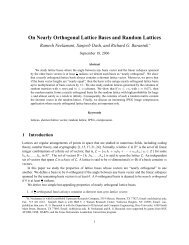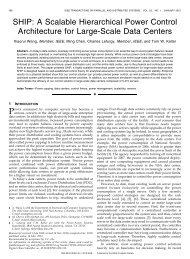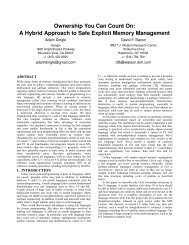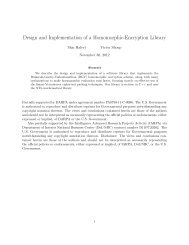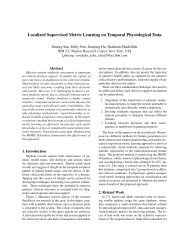SSS: A Hybrid Architecture Applied to Robot Navigation - CiteSeerX
SSS: A Hybrid Architecture Applied to Robot Navigation - CiteSeerX
SSS: A Hybrid Architecture Applied to Robot Navigation - CiteSeerX
You also want an ePaper? Increase the reach of your titles
YUMPU automatically turns print PDFs into web optimized ePapers that Google loves.
However, it is well known that over long distances suchmeasurements can drift quite severely due <strong>to</strong> differingsurface traction and non-planar areas.We solve the loop problem by exploiting the geometryof the environment. In most office buildings all corridorsare more or less straight and meet at right angles. Thereforewe measure the length of each path segment and treat thisas a straight line. Similarly, when the robot switches fromone path <strong>to</strong> another we force the turn <strong>to</strong> be a multiple of90 degrees. This is essentially an odometric representationwhich is recalibrated in both heading and travel distance ateach intersection. In this way we maintain a coarse (x, y)position estimate of the robot which can be compared <strong>to</strong>the s<strong>to</strong>red coordinates of relevant places.2.1: Tactical navigationTactical, or moment-<strong>to</strong>-moment control of the robot ishandled by the servo and subsumption layers of ourarchitecture. The servo layer consists of two velocitycontrollers, one for translation and one for rotation, on therobot base. These proportional controllers operate at 256Hz and have acceleration-limited trapezoidal profiling.Built on <strong>to</strong>p of these servo-controllers are variousreactive behaviors which run at a rate of 7.5Hz. One of themore important of these is wall following. For this we usea carefully arranged set of side-looking infrared proximitydetec<strong>to</strong>rs. The method for deriving of specific responses foreach sensory state is detailed in [4, 6] for similar systems.While some researchers have tried <strong>to</strong> fuse sensory data overtime and then fit line segments of it, most Òwalls" that wewant <strong>to</strong> follow are not really flat. There are always gapscaused by doors, and often junk in the hall that makes thewalls look lumpy. This is the same reason we did not try<strong>to</strong> implement this activity as a servo-controller: it is veryhard <strong>to</strong> directly extract angle and offset distance from thetype of sensory information we have available. Thematched filter approach lets us get way with only partialrepresentations of the environment relative <strong>to</strong> the robot.There are also two tactical navigation modules based onodometry. The first of these looks at the cumulative traveland slows or s<strong>to</strong>ps the robot when the value gets close <strong>to</strong> aspecified distance. A similar setup exists based on theaverage heading of the robot. The average heading iscomputed by slowly shifting the old average heading value<strong>to</strong>ward the robot's current direction of travel. If the robot isonly turning in place the average heading does not change,but after the robot has travelled about 5 feet in a newdirection the value will be very close <strong>to</strong> the actual heading.A special behavior steers the robot <strong>to</strong> keep this Òtail"straight behind, which in turn causes the robot <strong>to</strong> remainaligned with its average heading. This is very useful forcorrecting the robot's direction of travel after it has veeredaround an obstacle. If the de<strong>to</strong>ur is short, the averageheading will not have been affected much.The average heading signal provides an interestingopportunity for the symbolic system <strong>to</strong> deliberately Òfakeout" the associated behaviors. For instance, the symbolicsystem can cleanly specify a new direction of travel for therobot by yanking around the robot's Òtail". This method isbetter than commanding the robot <strong>to</strong> follow a new absolutedirection, especially for cases in which the robot was notaligned precisely with the original corridor or in which thenew corridor seems <strong>to</strong> bend gradually (in actuality or fromodometric drift). Instead of forcing the robot <strong>to</strong> continuallyscrape its way along one wall or the other, the averageheading will eventually adjust itself <strong>to</strong> reflect the directionalong which progress has been made and thereby allow therobot <strong>to</strong> proceed smoothly.Although they sound like servo-controllers, the twoodometric behaviors were put in the subsumption layer fortwo reasons. First, they do not require fine-grained errorsignals. The alignment behavior is quiescent if the robot isÒclose" <strong>to</strong> the right heading, and the travel behavior onlyslows the robot when it is Ònear" the goal. Second, andmore importantly, we wanted these behaviors <strong>to</strong> interactwith other subsumption behaviors. For example, thealignment behavior takes precedence over the part of wallfollowing that moves the robot closer <strong>to</strong> a surface,however it is not as important as collision avoidance.Many of these other behaviors are necessarily cast in asubsumption style framework because of the limitedquality of sensory information available. Thus, <strong>to</strong>accommodate the appropriate dominance relations, thealignment and travel limiting behaviors were also includedin this layer.2.2: Strategic navigationThe strategic part of navigation Ð where <strong>to</strong> go next Ð ishandled by the symbolic layer. To provide thisinformation, our symbolic system maintains a coarsegeometric map of the robot's world. This map consists of anumber of landmarks, each with a type annotation, and anumber of paths between them, each with an associatedlength. The landmarks used in the map are the suddenappearance and disappearance of side walls. These aredetected by long range IR proximity detec<strong>to</strong>rs on each sideof the robot. Normally, in a corridor the robot wouldcontinuously perceive both walls. When it gets <strong>to</strong> anintersection, suddenly there will be no wall within range ofone or both of these sensors. Similarly, when the robot iscruising down a corridor and passes an office, the IR beamwill enter the room far enough so that no return is detected.




